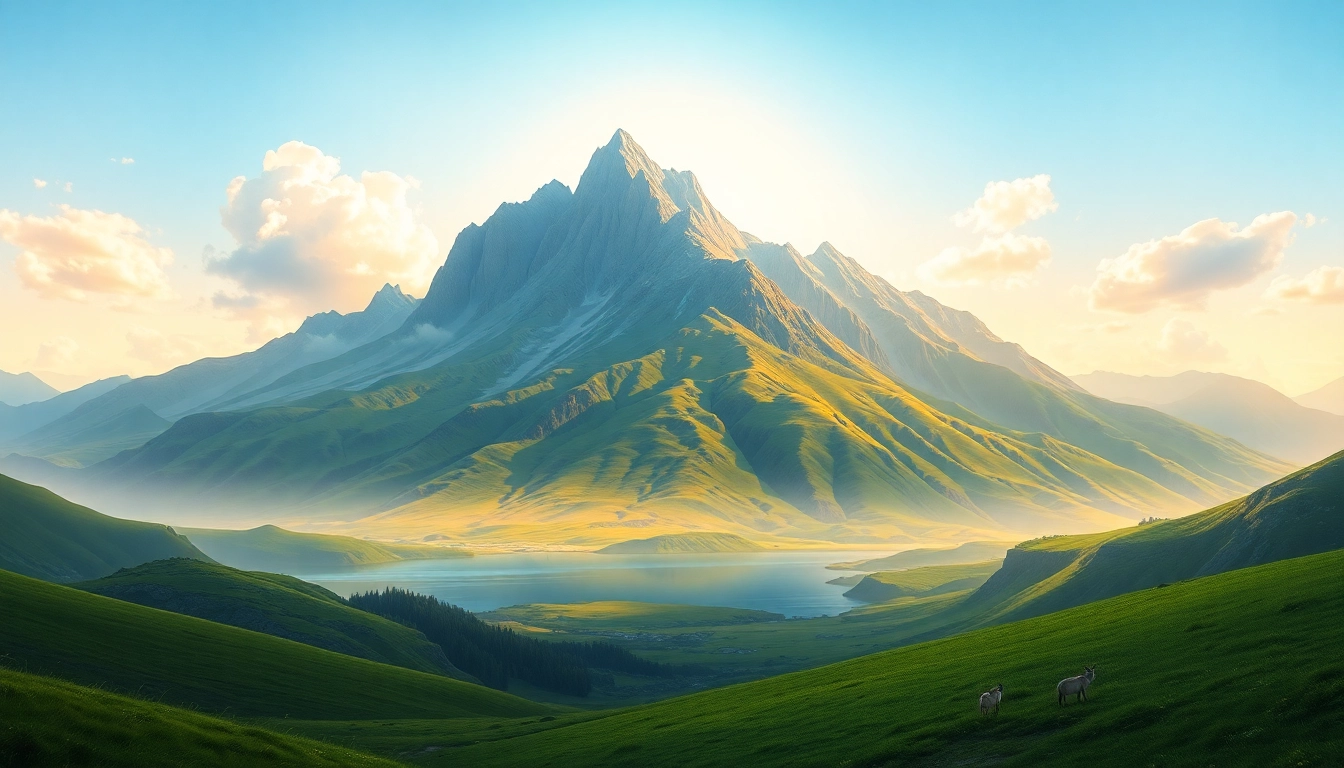Understanding the Essence of Landscape Paintings
Landscape paintings capture the beauty and majesty of nature, portraying scenes that evoke a sense of serenity and wonder. From sprawling valleys and majestic mountain ranges to tranquil lakes and vibrant forests, landscape paintings serve as a window into the natural world, inviting viewers to embark on a visual journey. The allure of these masterpieces has captivated artists and art lovers alike for centuries, making them one of the most popular genres in visual art.
The Historical Significance of Landscape Paintings
The roots of landscape painting can be traced back to ancient civilizations, where artists depicted natural scenery in various forms, often incorporating elements of mythology and spirituality. The genre gained prominence during the Renaissance, as artists began to appreciate the beauty of the natural world around them. Pioneers like Leonardo da Vinci and Albrecht Dürer showcased landscapes not merely as backdrops for human figures but as subjects worthy of attention.
In the 16th and 17th centuries, landscape painting evolved further with the work of the Dutch Masters, such as Jacob van Ruisdael and Aelbert Cuyp, who portrayed realistic and atmospheric landscapes. This period saw a shift from idealized representations of nature to more accurate depictions, thus laying the groundwork for future movements.
Different Styles in Landscape Paintings
Landscape painting encompasses various styles, each characterized by unique techniques, color palettes, and emotional undertones. Some key styles include:
- Realism: Focused on accurately representing the natural world, artists such as John Constable and Winslow Homer embraced realism in their landscapes, capturing light, shadow, and detail with fidelity.
- Impressionism: This late 19th-century movement, led by artists like Claude Monet and Camille Pissarro, aimed to capture the transient effects of light and atmosphere, often painting en plein air (outdoors) to achieve immediacy.
- Romanticism: Romantic landscape painters, including Caspar David Friedrich, infused their works with emotional intensity, using dramatic compositions to evoke feelings of awe and contemplation.
- Abstract Landscapes: Abstract artists such as Georgia O’Keeffe reinterpreted landscapes, focusing on shapes, colors, and forms to convey feelings rather than realistic representations.
Common Themes and Motifs in Landscape Paintings
Landscape paintings frequently explore themes of nature’s beauty, serenity, and even its tumultuous aspects. Common motifs often include:
- Seasons: The shifting seasons profoundly influence landscape painting, with artists capturing the vibrancy of spring blooms, the warmth of summer, the richness of autumn, and the starkness of winter.
- Water: Lakes, rivers, and oceans are recurrent subjects, representing tranquility or tumultuous nature, as seen in works by Turner or Monet.
- Mountains: Majestic mountain ranges symbolize strength and endurance, offering a canvas for exploration of solitude and grandeur.
- Urban Landscapes: As cities evolved, artists began to explore urban landscapes, incorporating human elements alongside nature, representing a fusion of industrial and natural beauty.
Techniques for Creating Landscape Paintings
Creating compelling landscape paintings requires a combination of technical skills and an understanding of nature. From choosing the right materials to mastering various techniques, aspiring artists can explore a vast range of tools and methods.
Essential Materials for Landscape Paintings
The choice of materials can greatly influence the final outcome of landscape paintings. Essential materials include:
- Paints: Artists typically use oil, acrylic, or watercolor paints to create landscapes, with oils providing rich, vibrant colors and a longer drying time for blending.
- Brushes: A variety of brushes (flat, round, and filbert) are essential for achieving different textures and effects.
- Canvas and Paper: Quality canvas or watercolor paper provides the foundation for painting, with the choice depending on the medium.
- Palette: A clean palette is crucial for mixing paints, allowing for a broader color range in the artwork.
Step-by-Step Guide to Painting Landscapes
Creating a landscape painting can be an enriching process. Here’s a simplified step-by-step guide:
- Choose a Subject: Select a landscape that inspires you, whether it be from photographs, real-life locations, or your imagination.
- Sketch the Composition: Use a pencil to outline the basic composition and placement of focal points.
- Lay Down the Sky: Start painting the sky first, using lighter colors and gradually building depth with darker hues.
- Establish Foreground and Background: Paint the background mountains or trees first, followed by the foreground elements like flowers or rocks.
- Add Details: Gradually layer colors and add details, focusing on creating depth and texture.
- Finishing Touches: Once satisfied, step back to assess the painting and make any final adjustments, ensuring balance and harmony in color and composition.
Tips for Achieving Realism in Landscape Paintings
To evoke a sense of realism, consider the following tips:
- Observe Real Landscapes: Take time to study the landscapes in person or through photographs to understand light, shadow, and color variation.
- Use a Limited Palette: Stick to a limited color palette to create a harmonious composition that mimics the subtle variations found in nature.
- Focus on Light: Pay attention to how light interacts with different surfaces, as capturing light effectively brings a landscape to life.
- Incorporate Textures: Use various brush techniques to depict textural elements such as grass, water, and bark, enhancing the overall lifelike quality.
Famous Landscape Paintings and Their Impact
Throughout history, many landscape paintings have left an indelible mark on the art world, influencing artists and movements alike. These masterpieces not only provide visual delight but also provoke thought and inspire viewers.
Notable Landscape Painters Throughout History
Several landscape painters have become icons within the genre, each contributing unique perspectives and techniques:
- J.M.W. Turner: Known for his expressiveness and dramatic effects of light, Turner’s works often reflect the power of nature.
- Claude Monet: A leading figure in Impressionism, Monet’s fascination with light and color revolutionized how landscapes are depicted.
- John Constable: Celebrated for his dedication to the natural landscape, Constable’s works resonate with emotional depth and detail.
- Georgia O’Keeffe: Through vibrant colors and abstraction, O’Keeffe portrayed the American Southwest’s landscapes, offering a fresh perspective.
Iconic Landscape Paintings and Their Stories
Iconic landscape paintings tell stories that reflect the relationship between humanity and nature. Some noteworthy examples include:
- The Fighting Temeraire by J.M.W. Turner: This painting symbolizes the transition from traditional sailing ships to modern technology, capturing the passage of time and change.
- Water Lilies by Claude Monet: A series of paintings showcasing Monet’s water lily garden, they epitomize Impressionism and the fleeting beauty of nature.
- The Oxbow by Thomas Cole: This work represents the conflict between civilization and nature, inviting viewers to reflect on the American landscape’s grandeur.
The Influence of Landscape Paintings on Modern Art
The legacy of landscape paintings continues to shape modern art. Contemporary artists draw inspiration from traditional techniques while exploring new mediums and concepts. Landscape painting has also become a vital component in environmental discourse, raising awareness of nature’s fragility and beauty.
Incorporating Landscape Paintings into Home Décor
Integrating landscape paintings into your home can enhance the ambiance and reflect personal style. The soothing imagery of nature resonates with many and can transform a space.
Choosing the Right Landscape Paintings for Different Spaces
When selecting landscape paintings, consider the space and mood you wish to create:
- Living Rooms: Opt for larger pieces that serve as focal points and invite conversation.
- Bedrooms: Softer, serene landscapes promote relaxation and tranquility, making them suitable for a restful environment.
- Offices: Energizing landscapes can inspire creativity and focus, ideal for workspaces.
Ways to Display Landscape Paintings Effectively
Displaying landscape paintings requires thoughtful consideration of space, lighting, and placement:
- Framing: Choose frames that complement the artwork and your decor style, enhancing its visual impact.
- Gallery Walls: Create a gallery wall by grouping various landscape artworks, allowing for a dynamic display.
- Lighting: Use spotlights or natural light to highlight the artwork, enhancing colors and details.
Creating a Cohesive Décor with Landscape Paintings
To achieve a cohesive look, consider the overall theme of your decor. Landscape paintings can harmonize with other elements:
- Color Palette: Match the colors in the artwork with your decor to create a visually unified space.
- Style: Ensure that the art style complements the room’s aesthetic, whether you prefer modern, rustic, or traditional themes.
- Integration: Blend landscape paintings with other decor elements, such as textiles and accessories that echo nature-inspired themes.
Where to Buy Quality Landscape Paintings
As the popularity of landscape paintings continues to rise, a variety of options exist for acquiring quality pieces that resonate with your taste.
Online Platforms for Landscape Paintings
Numerous online platforms offer an extensive selection of landscape paintings, making it easier for art enthusiasts to find unique pieces. Websites that specialize in art sales often feature a vast range of styles and artists, allowing for easy browsing and purchasing.
Art Fairs and Galleries for Landscape Paintings
Attending local art fairs and visiting galleries provides an opportunity to connect with artists directly. Many galleries showcase landscape paintings, often providing stories behind the works, enhancing the connection and ownership of the artwork.
Commissioning Custom Landscape Paintings
For those seeking a personalized piece, commissioning a custom landscape painting is an excellent choice. Working closely with an artist allows you to express your vision, ensuring that the final piece reflects your preferences and experiences.



